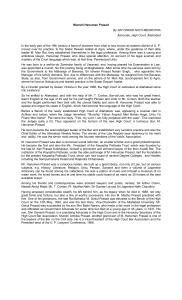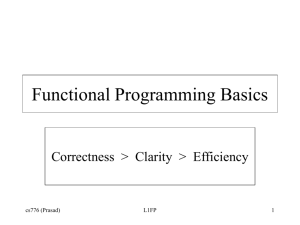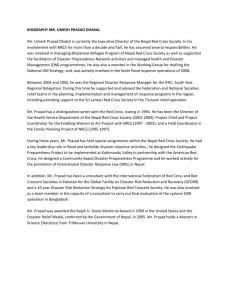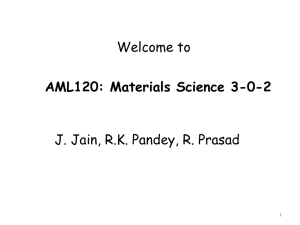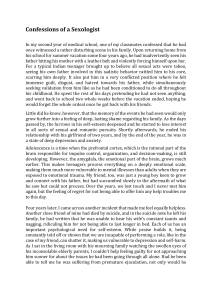XII Eng Core SQP2019
advertisement
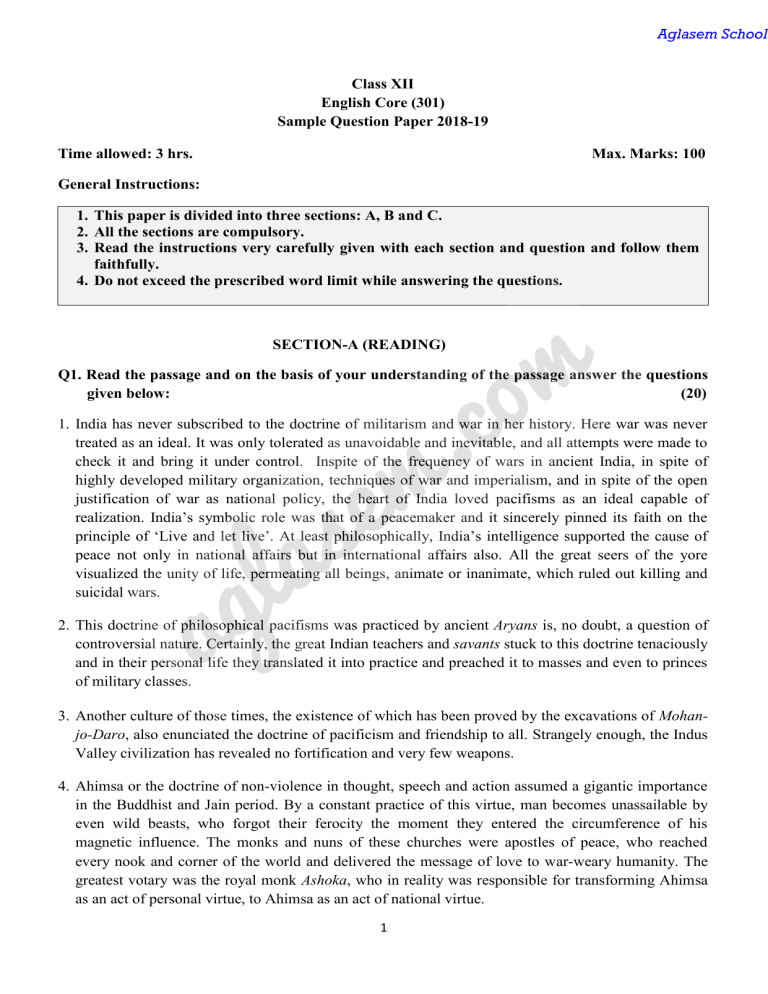
Aglasem School Class XII English Core (301) Sample Question Paper 2018-19 Time allowed: 3 hrs. Max. Marks: 100 General Instructions: 1. This paper is divided into three sections: A, B and C. 2. All the sections are compulsory. 3. Read the instructions very carefully given with each section and question and follow them faithfully. 4. Do not exceed the prescribed word limit while answering the questions. SECTION-A (READING) Q1. Read the passage and on the basis of your understanding of the passage answer the questions given below: (20) 1. India has never subscribed to the doctrine of militarism and war in her history. Here war was never treated as an ideal. It was only tolerated as unavoidable and inevitable, and all attempts were made to check it and bring it under control. Inspite of the frequency of wars in ancient India, in spite of highly developed military organization, techniques of war and imperialism, and in spite of the open justification of war as national policy, the heart of India loved pacifisms as an ideal capable of realization. India‟s symbolic role was that of a peacemaker and it sincerely pinned its faith on the principle of „Live and let live‟. At least philosophically, India‟s intelligence supported the cause of peace not only in national affairs but in international affairs also. All the great seers of the yore visualized the unity of life, permeating all beings, animate or inanimate, which ruled out killing and suicidal wars. 2. This doctrine of philosophical pacifisms was practiced by ancient Aryans is, no doubt, a question of controversial nature. Certainly, the great Indian teachers and savants stuck to this doctrine tenaciously and in their personal life they translated it into practice and preached it to masses and even to princes of military classes. 3. Another culture of those times, the existence of which has been proved by the excavations of Mohanjo-Daro, also enunciated the doctrine of pacificism and friendship to all. Strangely enough, the Indus Valley civilization has revealed no fortification and very few weapons. 4. Ahimsa or the doctrine of non-violence in thought, speech and action assumed a gigantic importance in the Buddhist and Jain period. By a constant practice of this virtue, man becomes unassailable by even wild beasts, who forgot their ferocity the moment they entered the circumference of his magnetic influence. The monks and nuns of these churches were apostles of peace, who reached every nook and corner of the world and delivered the message of love to war-weary humanity. The greatest votary was the royal monk Ashoka, who in reality was responsible for transforming Ahimsa as an act of personal virtue, to Ahimsa as an act of national virtue. 1 Aglasem School 5. Many a historian recounting the causes of the downfall of the Mauryas, hold the pacific policy of Ashoka which had eschewed the aggressive militarism of his predecessors, responsible for an early decay of the military strength of the state and its consequent disintegration, leading to the rise of Sungas, Kanvas and Andhras. But, in reality the fault lies with the weak successors of Ashoka, who could not wield the weapon of non-violence with a skill and efficiency which required the strength of a spiritual giant like Ashoka. They failed due to their subjective weakness: Pacifism itself was no cause of their failure. 6. Besides the foregoing philosophical and religious school of thought, even many political authorities gave their unqualified support to the cause of pacifisms. They recognized the right of rivals to exist, not mainly as enemies, but as collaborators in the building of a civilization operation. Thus, for centuries, in the pre-Mauryan India, scores of small independent republics existed and flourished without coming in clash with each other. 7. With regard to Kautilya, the much maligned militarist and the so called Machiavelli of India, He thinks that the object of diplomacy is to avoid war. 8. The Mahabharata observes in the connection, “A wise man should be content with what can be obtained by the expedients of conciliation, gift and dissention.” It denounces the warring world of men by comparing it to a dog-kennel. “First there comes the wagging of tails, then turning of one round to other, then the show of teeth, then the roaring and then comes the commencement of the fights. It is the same with men; there is no difference whatever.” Yajnavalkya adds: „War is the last expedient to be used when all others have failed.” Likewise, Sri Krishna who‟s Bhagwad-Gita has been styled by some as „a song of the battle‟, should not be considered out and out militarist. When all the three expedients were exhausted, then alone the fourth was resorted to. 9. All possible avenues of peace such as negotiation, conciliation through conference, meditation and so on, were explored before the war was resorted to. This proves that the heart of ancient India was sound and it longed for peace, although war also was not treated as an anathema, which was to be avoided as far as possible. (Words– 737) (Extract from ‘Culture India-Pacifism has been the Ideal’ by Sri Indra) 1.1 Answer each of the questions given below by choosing the most appropriate option: (i) The heart of India loved ____ a) a highly developed military organization b) techniques of wars and imperialism c) loans d) pacifism (ii) Principle of „Live and let live‟ means a) imperialism b) militarism c) frequency of wars among nations d) role of peace makers 2 (1X5=5) Aglasem School (iii) Aryans preached and practiced this to the masses a) non-violence b) freedom of speech and action c) philosophical pacifisms d) practice of military organization (iv) Mahabharata compares the warring world with a) wise men b) dog kennel c) song of the battle d) militarist (v) Unearthing Mohan-jo–Daro reinforced the following of Pacifism a) there was no fortification and very few weapons b) they delivered the message of love c) they were apostles of peace d) thinks that the object of diplomacy is to avoid war 1.2 Answer the following questions briefly: (1X6=6) (i) How was war treated in India? (ii) Describe India‟s preparedness for war in spite of their belief in Pacifism. (iii) How did the Aryans practice the Doctrine of Pacifism? (iv) What is Ahimsa? (v) What is the meaning of co-existence with rivals? (vi) Why should Bhagvad-Gita not be considered as “A song of the battle”? 1.3 Answer any three of the following questions in 25-30 words: (2X3=6) (i) What kind of unity did all the seers visualize? (ii) By some, Ashoka was considered as the cause of the downfall of the Mauryas. Do you agree? Give reasons for your answer. (iii) Which options were explored by Sri Krishna before resorting to war? (iv) Throw some light on the thinking of Kautilya regarding war. 1.4 Pick out the words/phrases from the passage which are similar in meaning to the following: (1X3=3) (i) express in definite and clear terms (para 3 ) (ii) defensive wall (para 3) (iii) the beginning (para 8) 3 Aglasem School Q 2. Read the passage and answer the questions given below: (10) 1. There is a clear dichotomy between Jayashankar Prasad’s daily life and the one that found expression in his literature. In his literary formulations, Prasad advocated an escape- frompersonality ideal and categorically stated: “An artist‟s art, and not his person, is the touchstone to assess his work . . . it is only after losing his personality that he emerges in his art as an artist”. 2. In Prasad‟s works – his poems, short stories, novels, dramas etc. – what emerges is life as shaped in the writer‟s inner self by his emotions, fancies, dreams, reveries . . . His writings are a record not of outer reality, but of the artist‟s inner world. As such, of a proper appreciation and understanding of his works more emphasis needs to be placed on the working of his mind, than the events of his dayto-day life. 3. Prasad was born in a renowned family of Varansi. His grand-father Shiv RatanSahu, a dealer in high quality perfumed tobacco (snuff). Besides being an astute businessman, he was endowed with a marked cultural taste. His home was the meeting place of the local poets, singers, artists, scholars and men of religion. Prasad‟s father Devi Prasad Sahu carried forward this high tradition of family. Prasad, therefore, had a chance to study the various phases of human nature in the light of the business traditions, artistic taste and religious background of his family. 4. When the business had somewhat recovered, Prasad planned the publication of a literary journal. Prasad started the “Indu”. The inaugural number appeared in July 1909. By this time Prasad‟s notions of literature had crystalized into a credo. In the first issue of Indu, he proclaimed, „Literature has no fixed aim; it is not slave to rules; it is free and all-embracing genius, gives birth to genuine literature which is subservient to none. Whatever in the world is true and beautiful is its subject matter. By the dealing with the True and Beautiful it establishes the one and affects the full flowering of the others. Its force can be measured by the degree of pleasure it gives to the reader‟s mind as also by criticism which is free of all prejudice”. The words sound like the manifesto of romanticism in literature. 5. Even while recognizing the social relevance of literature, Prasad insisted, “The poet is a creator . . . he is not conditioned by his milieu; rather it is he who moulds it and gives it a new shape; he conjures up a new world of beauty where the reader for the time being, becomes oblivious of the outer world and passes his time in an eternal spring garden where golden lotuses blossom and the air is thick and pollen”. Thus, the chief aim of literature according to Prasad is to give joy to the reader and to create a state of bliss in him. Later under the impact of Shaivadvaitism, this faith of Prasad got further strengthened. (word length- 490) (Extract from ‘Jayashankar Prasad- His mind and Art’ by Dr. Nagendra) 2.1 On the basis of your understanding of the above passage, make notes on it using headings and subheadings. Use recognizable abbreviations (wherever necessary-minimum four) and a format you consider suitable. Also supply an appropriate title to it. (5) 2.2 Write a summary of the passage in about 100 words. 4 (5) Aglasem School SECTION: B (ADVANCED WRITING SKILLS) Q.3 You are Simar / Smriti of Lotus International School, Jodhpur. Your school is organizing a workshop on „Prevention of Drug Abuse‟ in the coming week. Prepare a poster with complete information for the students of class X-XII. (4) OR You are Simar / Smriti of Lotus International School, Jodhpur.Your school has decided to contribute in controlling traffic near your school and requires the names of volunteers from IX to XII. Write a notice to be displayed on the notice board. (50 words) (4) Q.4 Public demonstration causes a lot of disturbance in daily routine of common man. You almost missed your important entrance examination as people blocked the highway. As Tarun / Taruna, a student aspiring to be a doctor, write a letter to the Editor of The Times of India highlighting the need to discourage such demonstrations and disturbance by public on highways which cause a great loss of time and opportunity for many. (100-125 words) (6) OR You are Tarun / Taruna who bought a new Luminous Inverter for your home from R.K. Electronics, Noida but found many functional problems as the charging is not done properly and battery water is getting leaked. Write a letter of complaint to the proprietor to take care of the same. (100-125 words) (6) Q.5 You are Mukul / Mahima of Alps Public School. Your school has organized a debate on „Social Media and It‟s Effects‟ and you will be participating from your school. Prepare your views against or in favour of the motion. (150-200 words) (10) OR As Mukul / Mahima of Alps Public School, write a speech to be delivered in school assembly highlighting the importance of cleanliness suggesting that the state of cleanliness reflects the character of its citizens. (150-200 words) (10) Q.6 By 2050, India will be amongst the countries which will face acute water shortage. You are highly alarmed and terrified of the future world without water. So, write an article on „Save water- are we doing enough?‟ for the local daily in 150-200 words. (10) OR You are Karan / Kirti of L.M. Memorial Public School, Dwarka. Your school has adopted a village as a social responsibility. Students are being taken to teach the children of that village on a regular basis. Write a report, for your school magazine, on the various other programmes organized there in 150-200 words. (10) 5 Aglasem School SECTION: C (LITERATURE: TEXT BOOKS and LONG READING TEXT) Q7. Read the following extract and answer the following questions briefly: What I want should not be confused with total inactivity. Life is what it is about; I want no truck with death. (i) (ii) (iii) (iv) Name the poem and the poet of the above stanza. What does the poet mean by „inactivity‟? Explain what life is all about, according to the poet? What is the ultimate expectation of the poet from all human beings? OR (1X4=4) When aunt is dead, her terrified hands will lie Still ringed with ordeals she was mastered by. The tigers in the panel that she made Will go on prancing, proud and unafraid. (i) (ii) (iii) (iv) Name the poem and the poet of the above stanza. What lies in store for the Aunt? Explain „ringed with ordeals‟. Identify and name the poetic device used in the last line of the above stanza. Q8. Answer any four the following questions in 30-40 words: (1X4=4) (3X4=12) (i) “We‟ve all a great deal to reproach ourselves with” said M.Hamel. Refer to the context and explain what he wanted to convey to his students. (ii) Why was Edla happy to see the gift left by the peddler? (iii)When Gandhi got the whole hearted support of the lawyers, he said, „The battle of Champaran is won‟. What was the essence behind his statement? (iv) Did the prophecy of the astrologer come true at the end of the story? How? (v) What were the indignities that Zitkala-Sa had to suffer for being from a marginalized community? (vi) What story did Jo want to hear the next day and why? What was father‟s reaction to it? Q 9. Answer any one of the following questions in 120-125 words: (6) (i) Mukesh is not like the others. His „dreams loom like a mirage amidst the dust of streets that fill his town Firozabad‟. Justify the statement in the light of contrast in the mindsets of Mukesh and the people of Firozabad. (ii) Unrealistic dreams often lead to a great deal of unhappiness. Justify the statement on the basis of the story „Going Places‟. (iii)The childhood experience of terror of Douglas made him stronger and more determined. Elucidate the above statement supporting it with evidences from the text. 6 Aglasem School Q10. Answer any one of the following questions in about 120-150 words: (6) (i) The servants of Sadao and Hana reflect a particular mindset of the general public in society towards the thinking and broad minded human beings. Elaborate with the help of the story „The Enemy”. (ii) Optimism in one‟s attitude helps deal with all the challenges in life. Prove the statement by referring to the character Mr. Lamb from the chapter „On the Face of It‟. (iii) Give a detailed account of the preparations made by the Governor for Evans James to write his examination. Q11. Answer any one the following questions in about 120-150 words: (6) (i) „I do not agree to this. Why dream of playing a game against the race. How can you hope to gain happiness? Do not be a lone wolf. Publish your results, take the world-take the nation at least-into your confidence„, said Dr. Kemp. These words sum up, to a large extent, the downfall of a genius like Griffin. Elucidate from the novel „The Invisible Man‟. (ii) Mr. Hall is a carefree man as he has a typical working life-partner in Mrs. Hall. Such persons are found in every society. Give a peep into both their characters. (The Invisible Man) (iii) How are the weavers treated differently from the farmers by the locals of Raveloe? (Silas Marner) (iv) Describe in your own words, the village of Raveloe. List some of the differences between Raveloe and Lanter Yard. Q12. Answer any one of the following questions in about 120-150 words: (6) (i) The unveiling of the stranger was as unplanned and sudden for himself as for the people of Iping. Explain the reason, incident and consequence of his unveiling. (ii) Describe and analyse the contribution of rustic characters in the development of plot of the novel, „The Invisible Man‟. (iii) What is the significance of Gold in the novel, „Silas Marner. (iv) In the war between love and luxury, love has priority. Justify on the basis of Silas Marner. ********** 7
